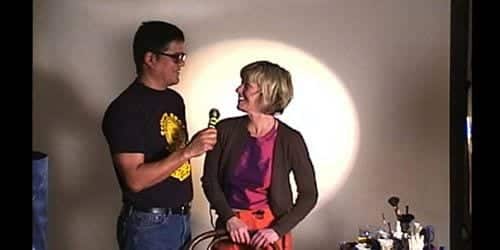
It’s really the interplay between me and the mirror while I’m shooting.
— Cindy Sherman
“I used to push Paul to make the show more professional,” says Walter Robinson. Back in the day — say, a decade ago — he and Paul Hasegawa-Overacker (who goes by Paul H-O) worked together on Art TV’s Gallery Beat, a public access show that set out to deflate the pretentious gallery scene via you-are-there revelations of openings, artist and industry interviews, and gadflyish commentary. No matter Robinson’s efforts, the show remained determinedly un-professional, alternately refreshing and ridiculous, insightful and self-indulgent. If, as H-O says, the show was “not an educational tool,” it was also, as Julian Schnabel describes it during a vaguely entertaining on-camera snit, “just a sort of masturbatory exercise in stupidity.”
Still, Gallery Beat ran its course, during which Robinson and H-O traded jokes and complaints with scene luminaries, seeing themselves as a sort of Beavis and Butt-head act, interloping and exposing the so-called art world (which Eric Bogosian here terms “one blow job after another”). Their antics coincided with what Christopher Trela calls “the advent of Me TV,” that is, part Ashton Kutcher-style gotcha, part reality TV, part gushy red-carpet send-up. While Robinson came with establishment credentials (art critic, writer, painter, and editor-in-chief of Artnet magazine), H-O was a commentator because he said he was, eschewing the usual claims to authority and performing his independence with panache, mixing self-conscious awe and passive-aggressive irreverence.
This dynamic changed, weirdly but also predictably, when H-O met Cindy Sherman. After years of refusing to engage with the press (“Part of my job,” recalls her assistant, “was politely telling people, ‘No'”), she agreed — after H-O spent months pursuing her — to do a series of interviews for what ended up as a half-hour of Gallery Beat called Cindyworld. As indicated in the fragments offered up in H-O’s documentary (co-directed by Tom Donahue), he and Sherman laughed and flirted during the shoot (“You’re like a virgin, a virgin to the video camera”), leading to an actual relationship. Or — as “actual” as might be possible between two individuals whose self-performing work and public identities interrogate exactly that concept.
The fact of this interrogation takes Guest of Cindy Sherman a long way, even if the film itself is not so clearly dedicated to it. Paralleling H-O’s seduction by the artist and the art world, the film shows him responding to fancy hotel rooms, celebrities, and the politics of Sherman’s work. At times, the film suggests Sherman is thinking through personal “issues” in her photos and so her romance with H-O (her friend and fellow artist Robert Longo observes, “She was so angry about men in the art world”); at other moments, it alludes to H-O’s own struggles to be taken seriously, based on his own accomplishments. As he explains during some kind of performance (the camera remains on his face, while an audience reacts off screen), he came to a point of no return when he found himself identified as “Guest of Cindy Sherman” by a dress-up dinner’s place setting card. “Even though it’s incredibly insignificant whether your name is on the name card or not,” H-O explains, “I’d sort of been swallowed up by the Cindy Sherman giant thing.”
On its face, this focus is not so provocative for the film. H-O’s hurt feelings over being the overlooked man in a relationship with a famous woman are surely familiar and not especially interesting. The film works at making these feelings seem important, including interviews with other famous or art-worldy couples grappling with a similar disparity (Molly Ringwald’s husband Panio Gianopoulos opines, “I didn’t really think that it should bother me and that was sort of the crux of the dilemma, because you think you should be above this”; Elton John’s husband David Furnish tells a story about feeling dissed at a party), as well as H-O’s appearances on a WMFU radio talk show. Asking whether he feels “bad and sexist” following his complaints, the women hosts observe the irony of H-O and Sherman’s particular intersecting interests: “She’s famous for doing photographs of women without an identity,” they note, then ask, “What can he do to get his identity back?”
The premise that H-O needs to get an “identity back” simplifies the film’s more compelling conundrums — the relationships between fame and image, art and value, popular culture and seeming high culture. Sherman’s work explores all of these concerns, initially, as the film contends, in a specifically “feminist” context. While the film includes montages of her photos that attest to their intrigues and politics, no matter various critics’ interpretations, it also indulges in the critical commentating. Sherman’s friend Charlie Clough observes that her ascent (as opposed to her male colleagues’ less spectacular successes), was in part a function of “magic timing.” As he has it, feminism, “the kind of attention that women’s issues were given at that point,” allowed her career, rather than considering the interactions among Sherman’s work, cultural politics, and art gallery business. On one hand, the film argues, the art world officially tired of macho posers like Schnabel and “feminist issues [became] full-blown.” On another hand, this shift reflected and led to self-doubts for “actual” (that word again) men, here embodied by H-O.
The problem is that his predicament remains uninteresting, which puts Guest of Cindy Sherman at a disadvantage. When she does appear on screen, she is, as H-O notes repeatedly, brilliant and endlessly appealing. Their breakup is anticlimactic, barely noted on screen, but his worrying about it — in and out of broader contexts — remains pervasive. The differences in the ways men and women perceive, construct, and manipulate identities in order to tell their stories continue to fascinate consumers, especially, perhaps, self-consumers.

